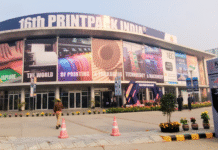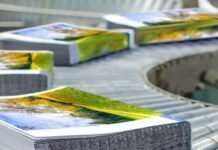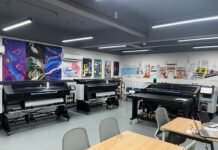
Last week Nessan Cleary wrote about the recent InPrint trade show in Munich, Germany which was published in the April issue of Indian Printer and Publisher. This report is the second half of that story which pertains to packaging. The ticket included entry to three shows, with the International Converting Exhibition or ICE being the main event, while InPrint shared its hall with the Corrugated and Carton Exhibition or CCE.
We might reasonably have expected to see a lot of inkjet in evidence at CCE given the number of inkjet presses designed to print to corrugated and folding carton. However, there was very little evidence of inkjet use in that part of the show, itself a useful reminder that this industry still represents a largely untapped potential for inkjet vendors. This is mostly because the show mainly appeals to those vendors that are already established in the mainstream corrugated space rather than the digital press vendors that have started moving into the corrugated world. Nonetheless, there were a few companies worth mentioning.
Efi
Efi used the CCE show to announce a new version of its Nozomi corrugated press, the Nozomi 14000 LED, a 1.4m wide machine that’s primarily aimed at the corrugated packaging market. I’ve already covered this in a separate story but essentially the 14000 is a compact version of the existing C18000 Plus, with the bigger machine also able to cater for display graphics for point of sale work. Richard Cotterill, global sales director for packaging at Efi, explains, “The format is more in keeping with cutters like the Bobst Master Cutter so this is designed to fit with the converting processes. We want to fit into existing production lines.”
The new machine sacrifices one of its color channels to achieve this more compact design. Fernando Tomas Badenes, global product director for Inkjet building materials and packaging division at Efi, says that the advantage of having all the printing engine in a single module is that it improves the color to color accuracy and the printing registration.
He adds, “The idea is that if you go compact instead of modular then the installation is much easier and faster because we don’t have to assemble all the modules.” He continues, “The servicing is much simpler because we have less components.”
Otherwise, the new Nozomi uses the same Seiko printheads and the same ink as the C18000 Plus. It still runs at 75mpm at 360 x 720 dpi. In addition, there is also a faster ‘Eco’ mode for uncoated materials of 100 mpm with a lower resolution of 280 x 360 dpi.
eProductivity Systems

Efi shared its stand with another company, eProductivity Systems, which split from Efi earlier this year. It does feel like the two companies are still negotiating the transition to being separate entities, particularly given that the Efi website still lists all the EPS software. For its part, EPS did demonstrate some new products, including a new version of its AutoCount software, AC4D, which is aimed at the corrugated market. AutoCount itself is a shop floor data collection system that can be used to track jobs through production. To do this it connects with most of the production equipment, which might be through installing a data collection kit or via a software interface. This can now be run off the cloud so it’s easy to access and work with once it’s integrated onto the shop floor.
Andrew Bennett, senior product specialist for EPS, explains, “We capture the status and the time for the makeready and throughout the print run. We can prompt the operator as to why the machine has stopped or if it is making waste. We track the operators so we know who is running the machine at any given moment. We track all the material in the machine, which is essential for pharmaceutical work.” He adds that the system can track jobs right through to fulfilment and even oversee printing of the delivery labels. The system will also carry out checks throughout a print run, with the customer determining what to check and what action to take if something fails a check. Bennett adds that AutoCount can be run on its own or as part of an ERP solution.
Macarbox

Macarbox, which manufactures a corrugating line as well as some converting equipment, has also developed a single pass inkjet printer for printing to uncoated corrugated board. The Digital Printing Machine or DPM is a 1.6m wide device that can take corrugated boards up to 3.5m long and from 1.5mm to triple corrugated in thickness. It has a modular design with different units including the feeder and stacker as well as the digital printer.
It has a maximum print speed of 80 meters per minute and uses water-based inks. It can be configured with up to eight color channels but the only colors available are CMYK so it’s a choice of either one or two sets of CMYK with a second row of heads allowing for faster speeds. There’s a choice of print resolution of 360 x 360 dpi or 360 x 720 dpi, with three different drop sizes, though Macarbox won’t say which printheads have been used other than that they come from Japan. Sales manager Amal Soualili says that it has slightly better quality than flexo printing. She adds that it is currently being tested and should be available within a few months. The price is likely to be around Euro 1.5 – 2 million depending on if the machine is fitted with a single or dual set of heads.
Neos

Few of the exhibitors had brought any equipment with them, which was perhaps not surprising given the size of most machinery associated with corrugated packaging. The Italian company Neos Digital Printing Solutions was one of the few exceptions, showing off one module from its Bombardier industrial printer, which was first introduced roughly six months ago. Sales director Stefano Paiano says that it has a modular design with each module holding two color bars so that users can start with a small two-color version or configure it with a wider print width and more colors by adding more modules. There are two versions, with one using a roll-to-roll transport system for flexible materials and the other using a belt drive for rigid substrates. The company works with printheads from several vendors, including Ricoh. Paiano says the company will customize each model according to the substrate being printed to. It can print to a wide range of materials, from paper and cardboard through to metal sheets. It can be used with water-based or UV LED inks and can run at up to 120mpm at 600dpi resolution but can also reach higher resolutions, depending on the heads in use.
Koenig and Bauer Durst
Koenig and Bauer Durst also had a stand at the show. The company has a number of presses, including the SPC130, which is mainly meant for printing to corrugated boards, and the VariJet for folding carton. Managing director Robert Stabler says that the company has installed several SPC130s and even has a few customers with multiple machines. He adds that the VariJet is still being beta tested, saying, “In folding carton the threshold is very high.” He adds, “The feedback on the quality has been without exception fantastic and that’s one of the things we worry about because its hard to match color and quality with offset.”
Koenig and Bauer Durst also sells the Corrujet and the Rotajet. Stabler says the CorruJet is more of a niche product, noting, “You need a lot of volume for it, around two million square meters a month.”
Michael Klafke, senior sales manager, says that the Rotajet has been sold into a number of high-quality niche areas, notably flooring, though with some installations planned for this year for packaging uses.
Kolbus
Kolbus showed off its Autobox AB310, which has an option to add a single color inkjet print bar. The company won’t say who supplies the printheads but it’s worth noting that because of space requirements the print bar fits underneath the media and jets upwards. It runs at 100mpm at 360 x 360 dpi resolution. The system also includes a vacuum with a roller to take out the dust and other debris that often accumulates within corrugated environments.

The show itself was well organized, with everyone having to provide proof of vaccination or negative Covid tests to enter the building. In addition, everyone had to wear masks indoors to comply with the rules in Germany at the time. This made it a little harder to recognize people from a distance. Naturally, visitors had to register before arriving, so that everyone had an electronic badge with a barcode. But on first presenting the barcode, integrated printers in the turnstiles spat out a paper badge, which was a better solution than just a digital badge on its own, especially as the WiFi signal at trade shows is never quite as good as everyone might hope.
Otherwise, the show itself seemed quite busy and since Germany was still in lockdown when most people were planning for this event I think that the number of exhibitors and visitors was quite encouraging. Most people I spoke to were optimistic that life will continue to get back to normality over the next few months – I do hope so as I have quite a few other European events this year that I’m planning to cover for Packaging South Asia as well!















